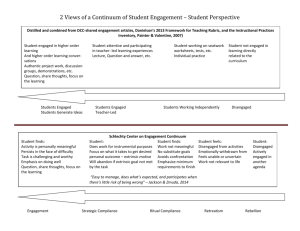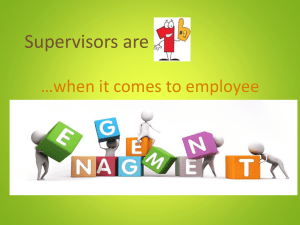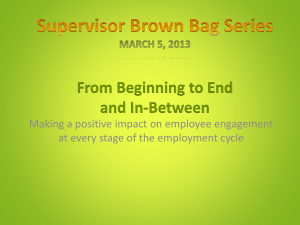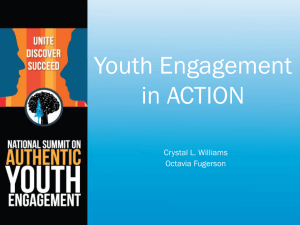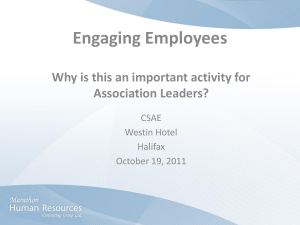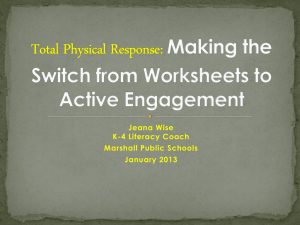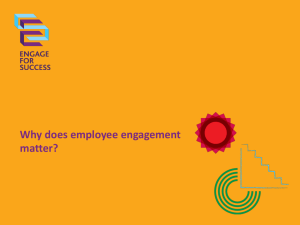The Power of Employee Engagement
advertisement
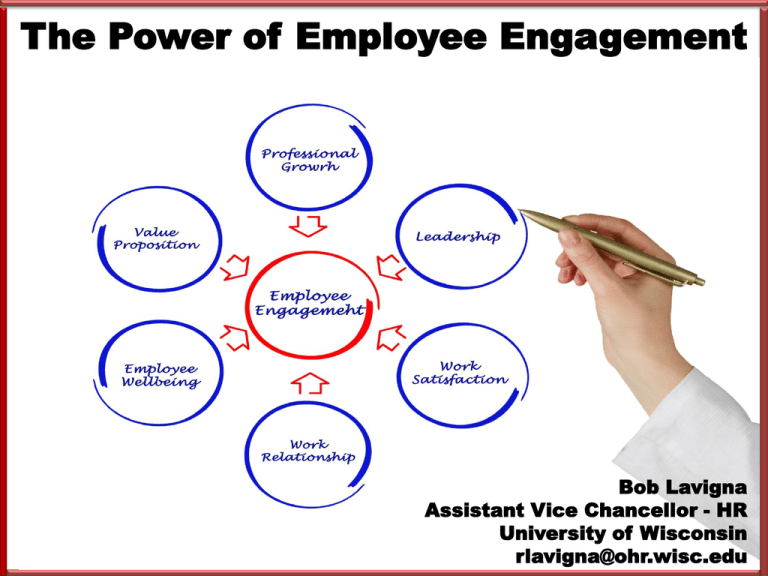
The Power of Employee Engagement Bob Lavigna Assistant Vice Chancellor - HR University of Wisconsin rlavigna@ohr.wisc.edu What We’ll Cover 1. What is employee engagement? 2. Why does it matter? 3. How do we know if our employees are engaged? 4. How have organizations achieved high levels of engagement? 5. How to get started Available through Amazon and Barnes & Noble Key Take-Aways Employee engagement matters Engagement levels are low HR has critical role – champion, facilitator and model But can be improved Engagement is not just an “initiative” or “program” Engagement should be measured Survey results must be acted on Our Aging Workforce 50% 45% 40% 35% 30% Federal State 25% Local 20% Private 15% 10% 5% 0% Under 30 30-39 40-49 50+ What is Employee Engagement? Heightened connection to work, organization, mission or coworkers Beyond job satisfaction or happiness Personal meaning in work • Pride • Belief their organization values them More likely to go above minimum and provide “discretionary effort.” Discretionary Effort Goe for customers Volunteers ideas Works hard – and smart Go extra mile for customers Doesn’t Volunteer ideas Work hard – and smart Don’t quit Call in sick only when ill quit Calls in sick only when ill Stays alert to safety hazards. Stay alert to safety hazards. Why Does Engagement Matter? Power of Employee Engagement Profitability Productivity Customer scores Safety incidents Lost or stolen inventory Turnover (low-turnover orgs) Turnover (high-turnover orgs)) Absenteeism -70% -60% -50% -40% -30% -20% -10% 0% 10% 20% Key Performance Indicators Top- and Bottom-Quartile Work Groups 30% What About in Government? U.S. Merit Systems Protection Board Fewer EEO complaints Less missed time Better success achieving strategic goals Higher retention Governing/ADP/IPMA-HR Engaged public sector employees: Twice as likely to stay in current job 2.5 times more likely to feel they can make a difference 2.5 times more likely to recommend their workplace to others Three times as likely to report being very satisfied in their jobs. Towers Watson Statement Highly engaged (% agree) Moderately Disengaged engaged (% agree) (% agree) I can impact quality 86 61 32 I can impact cost 59 37 21 I can impact customer 72 service 50 28 Deloitte Higher levels of engagement drive: Improved employee performance to support mission More collaborative and innovative work environments Lower costs of disengagement. Levels of Employee Engagement Worldwide 24 13 63 Engaged Not Engaged Actively disengaged Engagement in the U.S. 18 28 54 Engaged Not Engaged Actively disengaged How About in Government? IPMA-HR/ADP/Governing – 58% engaged MSPB • 35% engaged • 47% somewhat engaged • 18% not engaged OPM Federal Employee Viewpoint Survey – 65% engaged UK People Survey – 58% engaged. Engaged Employees Have strong relationships in organization Stay – even for less money Highly motivated to work hard Go the extra mile Recommend organization as good place to work On the Other Hand … Not engaged Not strongly committed to organization Feels trapped Gives bare minimum Actively disengaged Poor relationship with organization Only going through the motions It’s About Leadership 35% of U.S. workers polled said they’d willingly forgo a substantial pay raise in exchange for seeing their direct supervisor fired How Do We Know If Our Employees are Engaged? Ask Them! Engagement Survey Questions Pride in work or workplace 1. My organization is successful at accomplishing its mission 2. My work unit produces high-quality products and services 3. The work I do is meaningful to me 4. I would recommend my organization as a place to work Satisfaction with leadership 5. Overall, I am satisfied with my supervisor 6. Overall, I am satisfied with managers above my immediate supervisor Engagement Survey Questions Opportunity to perform well 7. I know what is expected of me on the job 8. My job makes good use of my skills and abilities 9. I have the resources to do my job well 10. I have sufficient opportunities (such as challenging assignments or projects) to earn a high performance rating Satisfaction with recognition received 11. Recognition and rewards are based on performance in my work unit 12. I am satisfied with the recognition and rewards I receive for my work Engagement Survey Questions Prospects for personal and professional growth 13. I am given a real opportunity to improve my skills Positive work environment and teamwork 14. I am treated with respect at work 15. My opinions count at work 16. A spirit of cooperation and teamwork exists in my work unit Engagement Process Model 1. Plan 5. Sustain Engagement and Resurvey 4. Take Action 2. Survey Communicate 3. Analyze Taking Action on Survey Data “Measurement Without Targeted Action is Useless” “You Said, We Did” Taking Action on Survey Data Form engagement teams Collect additional data Identify priorities – areas of strength and weakness Focus on individual work units Develop and implement action plans Provide education and training Identify outcome measures Establish accountabilities Communicate How Do We Achieve High Levels of Engagement? Effective Practices Engagement is everyone’s responsibility It must be a strategy Lead from the top Involve unions Hire with care; probation is part of selection Onboard well. Effective Practices Select supervisors who can supervise – and build engagement Give them training, resources and support Hold supervisors accountable for engagement Effective Practices Manage performance • Make sure employees know what is expected – and how work links to mission • Meet regularly with employees • Provide opportunities to grow and develop • Hold employees accountable – avoid transferring poor performers Recognize contributions Make sure employees’ opinions count Create a positive work environment – respect work/life balance Communicate Measure and re-measure engagement. Onboarding Model What is HR’s Role? Champion engagement Drive cultural change Facilitate process Identify organizationwide issues Be a role model Lead action Building a Culture of Engagement A set of accepted organizational values, behaviors, and practices that promotes increasing levels of engagement as a cultural norm Getting Started Getting Started Make the long-term commitment Communicate the business case Get leaders, managers and supervisors on board Involve unions Plan and communicate strategy Survey employees Follow through Key Take-Aways Employee engagement matters Engagement levels are low HR has critical role – champion, facilitator and model But can be improved Engagement is not just an “initiative” or “program” Engagement should be measured Survey results must be acted on Thank You rlavigna@ohr.wisc.edu
